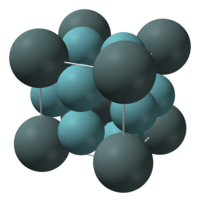
Photo from wikipedia
Abstract The aim of this study is to evaluate a new nondestructive method designated as Low-Field Magnetic Analysis (LFMA) based on the measurement of magnetic flux density for monitoring sigma… Click to show full abstract
Abstract The aim of this study is to evaluate a new nondestructive method designated as Low-Field Magnetic Analysis (LFMA) based on the measurement of magnetic flux density for monitoring sigma (σ) phase precipitation in duplex stainless steel (DSS). In addition, the effect of isothermal aging treatment at 800 °C on the metallurgical degradation of UNS S31803 DSS was investigated. It was found a change in the volume fraction of α-Fe/γ-Fe phases due to α-Fe (ferromagnetic phase) eutectoid decomposition to precipitate sigma and secondary austenite (paramagnetic phases). A significant and gradual reduction of saturation magnetization was observed with the increase of thermal treatment time, indicating a decrease in the quantity of α-Fe phase. Two magnetic methods were used to verify the evolution of the σ phase: M−H measurements at 300 K using a commercial magnetometer and LFMA testing. Both methods were sensitive to small percentages of σ phase in the microstructure. Furthermore, our developed technique presents accurate results for low magnetic fields with high sensitivity and reliability.
Journal Title: Journal of Magnetism and Magnetic Materials
Year Published: 2020
Link to full text (if available)
Share on Social Media: Sign Up to like & get
recommendations!